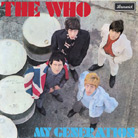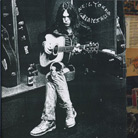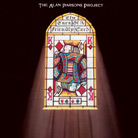![[SoundStage!]](../sslogo3.gif) The Vinyl Word The Vinyl WordBack Issue Article |
January 2006 Found on Vinyl: The Who, Neil Young, and The Alan Parsons Project At a meeting of my local B.B.A. chapter (Baby Boomers Anonymous), we had a major confessional breakthrough. We discovered that most of our classic-rock LPs are pretty much trashed, the result of all those years of play on less-than-stellar turntables (or, horror of horrors, LP changers) with cheapo cartridges that had coins taped to their headshells. I’m in the same boat -- minus the coins. How I’d love to find mint copies of many of those favorite albums that were damaged through years of rough play, so I can hear them cleanly again. Classic Records, sensing an opportunity, has come to the realization that what I want is what many audiophiles might be looking for as well. Thus, we can reacquaint ourselves with albums by Led Zeppelin, Genesis, Crosby, Stills, Nash & Young, and Jimmy Hendrix that aren’t trashed from the abuse we gave them before we found our audiophile calling. Getting to hear them mastered with boatloads of TLC -- which in many cases they never received when initially issued -- and pressed on thick virgin vinyl is quite a treat. Well, we’ve been additionally blessed with three more titles from the golden age of album-oriented rock'n'roll -- from The Who, Neil Young, and The Alan Parsons Project.
But finding an original mono Brunswick (then a division of Decca records) pressing in decent shape can be a time-consuming, expensive, and possibly futile endeavor, given the 40-year interval between release and today -- and the number of times such an album was likely played during that span. And yet, much like the Hendrix catalog Classic Records has been reissuing, My Generation was initially mixed in mono -- the stereo release was more of an afterthought -- so it’s funny that the monos are so hard to come by. But hearing the album reproduced in mono is more in line with the way the band and its producers and engineers originally wanted you to hear this music. Hence Classic’s choice to release this reissue in mono on now-standard 200-gram Quiex SV-P vinyl. It came out of the cover flat and played wonderfully quiet -- not that one would even notice an occasional tick or pop, given the raucous nature of the music. Interestingly enough, this album has been recently released on hybrid SACD by Universal (owner of the Decca catalog) -- in stereo. It sounds very good, and is well worth picking up if you’re digitally inclined. But it doesn’t hold a candle to the Classic vinyl reissue. Using the mono switch on my preamp, I listened to both, and the Classic LP is much more present, offering a clearer window into the music than the well-remastered SACD: Townsend’s guitar has more bite, Moon’s drums have more drive and sound more realistic, and Entwistle’s bass is much better defined. The sense of real musicians playing in your presence is more convincingly reproduced on the mono vinyl than the SACD in mono or stereo. In the mid-1970’s, Neil Young released a three-LP set called Decade that was his up-to-then greatest-hits anthology. Containing most of the songs that listeners associated with Young’s career, Decade was the choice for the non-obsessive Neil Young fan. It was not pressed on the best vinyl, however, and was sourced from second- (or third-) generation masters. Because Young has far from quit the music scene, Decade is no longer fully representative of his output -- a fact that Young himself acknowledges. So he has gone back, found the original master tapes, and, through the kind auspices of Classic Records, issued his latest Reprise Records Greatest Hits [Reprise/Classic 48935-1] album on two 200-gram LPs. Also included is a bonus 7" 45rpm single containing "The Loner" backed with "Sugar Mountain," with nary an indication that Classic had any hand in its release. Now that’s class.
This is possibly the best-sounding Neil Young LP ever, and I’ll go on record that it’s the best pressed. Listen to side three in particular and see if you don’t agree. It is superbly reproduced. This Greatest Hits album is the actual Mona Lisa compared to a photocopy when considered with Decade. It sounds as if you are hearing freshly minted master tapes. Young and his guitar are in-the-room real. Bass is deep, full and tight. The drums, especially the kick drum, thump and snap, and the cymbals shimmer. The sound just leaps from the speakers. Decade offered more music, but the Classic set is the one I’ll be reaching for when I want my Neil Young fix. My copy was beautifully quiet, which further allowed the music to draw me in. This release is an instant audiophile classic.
As with any of the Alan Parsons Project releases, The Turn of a Friendly Card has the prerequisite hits on it, so it would appeal to the FM audience of the day. In this case, "Time," sung by Eric Woolfson, and "The Games People Play," sung by Lenny Zahatek, fill the bill. Both sound fine, if a bit dated. This is one of those albums that you’ll buy because you enjoyed it when it first came out, not because it’s a rock classic, made history, or set any sales records. The sonics of this 200-gram reissue are very well reproduced. Parsons was a proponent of the wall-of-sound style of recording, and The Turn of a Friendly Card is no exception. The soundstage is wide, but not particularly deep -- no surprise, given that this is an electronic rock recording. Instruments are well reproduced, especially the keyboards and drums. The vocals, while clear enough, don’t have a 3D sense of realness. Still, an enjoyable release, if not a choice I would have made for the Classic Records treatment. We audiophiles really are hard to please. You’ve got to hand it to Classic Records. Not content to rest on the accolades garnered from their superb RCA Living Stereo classical releases or their ongoing Blue Note jazz reissues, they've recognized that fans of timeless rock'n'roll would appreciate well-done reissues, too. So out they come, done to the nines. Baby Boomers like me can update our collections with these classic records from Classic Records. ...John Crossett |
|
![[SoundStage!]](../sslogo3.gif) All Contents All ContentsCopyright © 2006 SoundStage! All Rights Reserved |
 The Who’s
debut album, My Generation [Brunswick/Classic LAT-8616-200], from 1965, unleashed
the band's hard-driving, guitar-crunching brand of blues-inspired rock'n'roll on an
unsuspecting but soon-to-be-very-appreciative audience. With tunes that ranged from the
Beatlesque "The Kids Are Alright," to the electric-blues-drenched "I’m
a Man," to the foretaste of things to come via both the title tune and the
group-penned "The Ox," My Generation exploded onto the music scene and
made The Who an immediate force. As debut albums go, this one is up there among the best.
The Who’s
debut album, My Generation [Brunswick/Classic LAT-8616-200], from 1965, unleashed
the band's hard-driving, guitar-crunching brand of blues-inspired rock'n'roll on an
unsuspecting but soon-to-be-very-appreciative audience. With tunes that ranged from the
Beatlesque "The Kids Are Alright," to the electric-blues-drenched "I’m
a Man," to the foretaste of things to come via both the title tune and the
group-penned "The Ox," My Generation exploded onto the music scene and
made The Who an immediate force. As debut albums go, this one is up there among the best. The back cover
states that the songs included here are "based on original record sales, airplay, and
known download history." Sure, this Greatest Hits leaves out many of
Young’s songs that his more hard-core fans consider essential, and it chops up albums
that may be better heard in their entirety. But that’s life. Remember, these are the
songs that Young wanted on this retrospective, and there’s only so much room anyway,
even on a double-LP set. What is here is significant, arranged chronologically from
1969 to 1991. It covers a lot of ground -- Young’s days with Crazy Horse ("Down
By the River," "Cowgirl in the Sand," "Cinnamon Girl," Like a
Hurricane" and "Hey Hey, My My"), through his days with Crosby, Stills,
Nash & Young ("Helpless" and "Ohio"), to his Stray Gator days
("Old Man" and "Heart of Gold"), through his solo years ("After
the Gold Rush," "Only Love Can Break Your Heart," "Southern Man,"
"The Needle and the Damage Done," "Comes a Time," "Rockin’
in the Free World" and "Harvest Moon").
The back cover
states that the songs included here are "based on original record sales, airplay, and
known download history." Sure, this Greatest Hits leaves out many of
Young’s songs that his more hard-core fans consider essential, and it chops up albums
that may be better heard in their entirety. But that’s life. Remember, these are the
songs that Young wanted on this retrospective, and there’s only so much room anyway,
even on a double-LP set. What is here is significant, arranged chronologically from
1969 to 1991. It covers a lot of ground -- Young’s days with Crazy Horse ("Down
By the River," "Cowgirl in the Sand," "Cinnamon Girl," Like a
Hurricane" and "Hey Hey, My My"), through his days with Crosby, Stills,
Nash & Young ("Helpless" and "Ohio"), to his Stray Gator days
("Old Man" and "Heart of Gold"), through his solo years ("After
the Gold Rush," "Only Love Can Break Your Heart," "Southern Man,"
"The Needle and the Damage Done," "Comes a Time," "Rockin’
in the Free World" and "Harvest Moon"). To many, a
musically worthy concept album is Pink Floyd’s classic Dark Side of the Moon.
However, groups such as The Alan Parsons Project brought the concept album to full flower.
Along with albums like Tales of Mystery & Imagination, I Robot, and Pyramid,
the Project's 1980 release Turn of a Friendly Card [Arista/Classic AR-8226], based
on the concept that gambling is the favorite pastime of many people, was one of their best
efforts, both musically and sonically. Parsons was the engineer on Dark Side of the
Moon, so his ears and dedication to excellent sound when working in this context are
fully established. His work as both producer and engineer on albums bearing his name was
done with equal skill, and he played some keyboards on the albums, too. As the group's
name would indicate, these albums are a collective effort. While there are core musicians
that Parsons called on, including buddy Eric Woolfson on keyboards and vocals and Ian
Bairnson on drums, most of the musicians came and went as needed. Still, the consistency
from track to track, always one of the hallmarks of a Parsons project, is astounding.
To many, a
musically worthy concept album is Pink Floyd’s classic Dark Side of the Moon.
However, groups such as The Alan Parsons Project brought the concept album to full flower.
Along with albums like Tales of Mystery & Imagination, I Robot, and Pyramid,
the Project's 1980 release Turn of a Friendly Card [Arista/Classic AR-8226], based
on the concept that gambling is the favorite pastime of many people, was one of their best
efforts, both musically and sonically. Parsons was the engineer on Dark Side of the
Moon, so his ears and dedication to excellent sound when working in this context are
fully established. His work as both producer and engineer on albums bearing his name was
done with equal skill, and he played some keyboards on the albums, too. As the group's
name would indicate, these albums are a collective effort. While there are core musicians
that Parsons called on, including buddy Eric Woolfson on keyboards and vocals and Ian
Bairnson on drums, most of the musicians came and went as needed. Still, the consistency
from track to track, always one of the hallmarks of a Parsons project, is astounding.